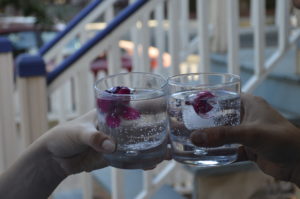Growing Edible Flowers
There are edible options for your garden beyond just fruits, vegetables, and herbs—you may be surprised to learn that many cut flowers are safe to eat! If they’re grown under the right conditions, some of the blossoms you already have growing could easily find their way into your lunchtime salad or decorate your favorite dessert.
Here are some common flowers that you can grow to cook with or to safely garnish a dish:
- Anise hyssop (Agastache foeniculum)
- Bachelor’s Button/Cornflower (Centaurea cyanus)
- Bee Balm/Bergamot (Monarda didyma)
- Begonia (Begonia x tuberhybrida)
- Borage (Borago officinalis)
- Breadseed Poppy (Papaver )
- Calendula (Calendula officinalis)
- Carnation/Sweet William (Dianthus)
- Chamomile (Matricaria recutita)
- Chrysanthemum (Chrysanthemum)
- Daisy (Bellis perennis)
- Dandelion (Taraxacum officinale)
- Daylilies (Hemerocallis)
- Echinacea (Echinacea)
- Fuchsia (Fuchsia spp.)
- Hibiscus (Hibiscus rosa-sinensis)
- Impatiens(Impatiens walleriana)
- Lavender (Lavendula)
- Lilac (Syringa vulgaris)
- Marigold (Tagetes tenuifolia)
- Nasturtium (Tropaeolum majus)
- Pansy/Johnny Jump Ups (Viola x wittrockiana)
- Queen Anne’s Lace (Daucus carota)
- Rose (Rosa)
- Sage (Salvia officinalis)
- Scented Geranium (Pelargonium)
- Sunflower (Helianthus annuus)
- Sweet Violet (Viola odorata)
Materials List
- Variety of plants from the above list
- Organic potting soil
- Trowel
- Gloves
- Organic fertilizer
To grow edible flowers:
- Pick Your Blooms. Begin with healthy, organically grown flower seedlings from your local nursery. Be aware that non-organic plants may have been treated with chemical pesticides and fertilizers, so look for seeds and plants that are labeled “organic.”
- Decide Where to Plant. Choose the best place to plant. Most of the plants listed above require at least 4–6 hours of direct sun each day. Flowers that can grow with less sun include nasturtiums, pansies, and violets. It’s also important to avoid planting edibles near a road or driveway where they can absorb car emissions and other toxins, or where they can be contaminated by dogs, cats, or other large animals. Planting in a container is a good option because it allows you to better control the environment and ensure it is sanitary.
- Prepare the Soil. If you’re planting in containers, use fresh, organic potting soil. If you’re planting them in the ground, avoid planting them in soil that has previously been treated with non-organic pesticides.
- Dig In and Plant. Remove the plants from the nursery containers; if the roots are overgrown and tangled, you can gently loosen them. Plant them in holes that are the same depth that they were in the nursery containers and water them well after planting.
- Keep Them Watered. Water the plants regularly—usually, 1 inch of water a week is sufficient for most flowering plants. If you’re recycling water from indoors, use only water that contains no soaps or cleaning products on edible flowers.
- Organic Food Only! Feed the plants only with organic, sustainable fertilizers. For example, compost or worm castings can be lightly worked into the soil around the plants, or fish emulsion can be diluted and watered onto the plants.
- Harvest the Beauty. To harvest the flowers, cut them early in the day, soon after the flower buds have opened. Keep the cut flowers in water to keep them fresh until you are ready to wash the edible parts and add them to your food.
 With some edible flowers it is safe to eat all parts of the plants, while some only have edible petals or other parts. You should research any flower you’re going to consume to make sure you are only using the parts that are safe to eat. With breadseed poppies and sunflowers, for example, it’s the seeds that are edible. Roses not only have edible petals, but the rose hips (seedpods) can be used for jellies, teas, or other dishes. Be aware too that some people can have allergic reactions to edible flowers, particularly to the pollen.
With some edible flowers it is safe to eat all parts of the plants, while some only have edible petals or other parts. You should research any flower you’re going to consume to make sure you are only using the parts that are safe to eat. With breadseed poppies and sunflowers, for example, it’s the seeds that are edible. Roses not only have edible petals, but the rose hips (seedpods) can be used for jellies, teas, or other dishes. Be aware too that some people can have allergic reactions to edible flowers, particularly to the pollen.
Once you start to explore and experiment, you’ll find there are endless ways to incorporate edible flowers into culinary dishes such as sorbets, marinades, desserts, reductions, or by adding a pop of flavor and color to salads and drinks!